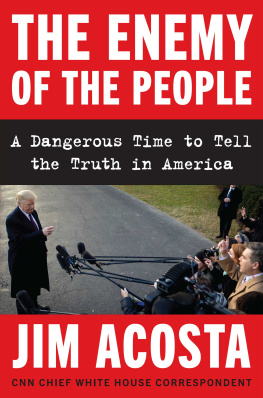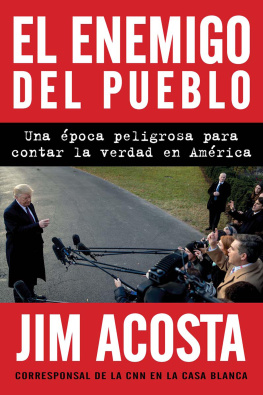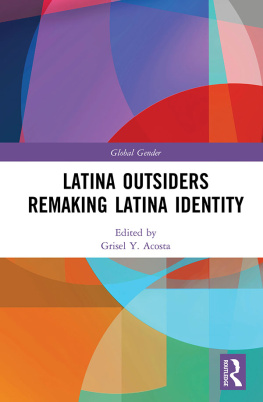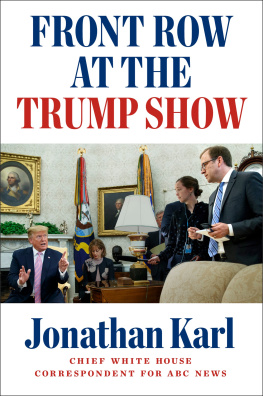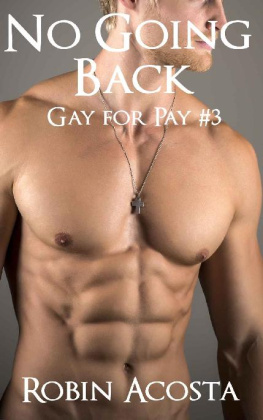Contents
Guide
For H.O.P.
Contents
This is CNN breaking news....
I was sitting on a plane just minutes after takeoff when the news alert flashed across the cabins TV screens. It was the morning of October 25, 2018, and I was en route from Washingtons Ronald Reagan National Airport to San Francisco, where I would be delivering a speech at San Jose State University on the state of the news business under President Donald J. Trump and accepting an award from the schools journalism program. Id been planning on using the flight to work on my speech, but suddenly I was glued to the screen in front of me.
The New York City Police Department had units surrounding the Time Warner Center at Columbus Circle, across from Central Park. CNNs headquarters was being evacuated after a suspicious package had been discovered in the buildings mailroom. A pipe bomb had been sent to CNN in New York, but its intended target was former CIA director John Brennan, a frequent Trump critic. The device was similar to bombs that had been mailed to Trumps leading Democratic Party adversaries, including former president Barack Obama and Trumps rival in the 2016 election, former secretary of state Hillary Clinton.
It has all been building up to some kind of act of violence, I thought.
I had feared the day would come when the presidents rhetoric would lead one of his supporters to harm or even murder a journalist. And when it happened, the United States would undergo something of a sea change, joining the list of countries around the world where journalists were no longer safe reporting the truth. Perhaps we have already entered that era, a dangerous time to tell the truth in America.
Of course, there wasnt a damn thing I could do about it from where I was, strapped to my seat at the beginning of a five-hour flight to Northern California. All I could do was watch as the images of domestic terrorism played out on my tiny in-flight TV.
Yes, for a reporter, there are few things worse than missing a big story like this one. But fear of missing out was not the emotion I was feeling at that moment. I was pissed off. Really, really pissed off. This was a terrorist attack on my news organization and, without a doubt, on the American free press.
Since the days before the Iowa caucuses in 2016, I had covered both Trumps unimaginable rise to power and his tumultuous presidency. My photographers, producers, and I had covered the rallies where Trump demonized the press, where he called us disgusting and dishonest, before moving on, at a news conference he held before being sworn into office, to dub my network and me fake news. We had listened to the chants of CNN sucks from his crowds of supporters, seen them give us the middle finger, and heard them call us traitors and scum. And of course, who could forget when the president of the United States said we were the enemy of the people?
On the way to California, I ripped up my original speech for the folks at San Jose State and started from scratch. The students, I had decided, would get the unvarnished truth about what I had been witnessing during my time covering Trump. I was afraid the president, I later told the crowd, was putting our lives in danger. But this was no time to back down. The truth, I argued, was bigger than a president who is acting like a bully. We were in a fight for the truth, and the stakes couldnt be higher.
Throughout Trumps race for the White House and during his first two years in office, I have been jotting down anecdotes, collecting quotes from sources, listening to stories from Trump aides and associates past and present, and stockpiling reflections on what is clearly the most important political story of my life. In many ways it is one I have been preparing to tell ever since I knew I wanted to be a journalist.
Growing up in the DC area, I have politics in my blood. The Washington Post was delivered to our house every morning. My parents were blue collar, but Mom read the Post from cover to cover each day. Dad worked at local grocery stores and came home with stories of meeting the likes of Dick Gephardt, the former Missouri congressman and Democratic presidential candidate. As for me, I went to high school with the daughter of U.S. senator Trent Lott. My best friend Roberts father, Eugene Dwyer, worked at the State Department.
Unlike a lot of young journalists these days, I took the traditional local news route to my jobs in network and cable news. Over the years, I worked everywhere, from DC to Knoxville to Dallas to Chicago, learning from some great journalists and covering everything under the sun. In local news, I was constantly on the go, running between city hall, the courthouse, and police headquarters. Thats how I began to cultivate sources, generate scoops, and, above all, report things to the best of my ability in a fair and accurate fashion.
Eventually, CBS News gave me the opportunity of a lifetime: working under the likes of Dan Rather and Bob Schieffer. I covered the war in Iraq, Hurricane Katrina, and the presidential campaign of John Kerry. It was an amazing transition for me, one that opened up a huge world of possibilities, but it was CNN that gave me the job I had always wanted, as a political reporter. In 2008, I covered Barack Obamas epic battle with Hillary Clinton. In 2010, I carved out a niche for myself covering the rise of the Tea Party (an assignment that would prepare me well for surviving Trumps rallies many years down the line). And two years later, the network had me covering Mitt Romneys failed presidential bid.
After Romneys defeat, CNN moved me over to the White House to cover Obamas second term. No drama Obama, as he was known, experienced plenty of drama during his final four years in office. The Benghazi attack, the ill-fated rollout of the Obamacare website, the rise of ISIS, and the scandal at the Department of Veterans Affairs were all serious challenges that plagued Obama, damaging his legacy as the president who stopped a second Great Depression and ordered the mission to take out Osama bin Laden. As it turns out, many of the stories that kept us busy during Obamas second term, such as ISIS and the presidents inability to pass immigration reform, teed up some of the themes Trump would ride into the Oval Office.
Long before he became a presidential candidate, Trump was a political fixture on cable news partly because of his devotion to the birther movement, which was fueled by the false conspiracy theory that Obama had not been born in the United States. Trump was one of the biggest proponents of this bogus claim about the nations first African American president. With his successful reality TV show, The Apprentice, Trump was already a star, but the birther conspiracy made him something of a household name in conservative circles, as he began popping up on the shows to talk about his strong suspicion that Obama wasnt really an American. It was shameful.
The Washington establishment, truth be told, did not consider Trump a credible figure. And President Obama brushed off the attacks coming from him as the rants of a carnival barker. Still, I remember that we in the press gave that outlandish birther lie a ridiculous amount of coverage.
After Trump declared his run for president in June 2015, few folks inside Obamas West Wing gave him good odds on winning the White House. For them, he was considered more of a punch line than presidential material. Hillary Clinton, they were convinced, would be the next president.
It didnt take long for that view to change.
By the fall of 2015, as Trump was beginning to draw large crowds at his rallies, I remember attending an off-record reception at the office of National Security Advisor Susan Rice. (Think drinks with the staff.) A top official asked me if I thought Trump could actually win the Republican nomination. Sure, I said. Just look at the massive audiences showing up at his events.

